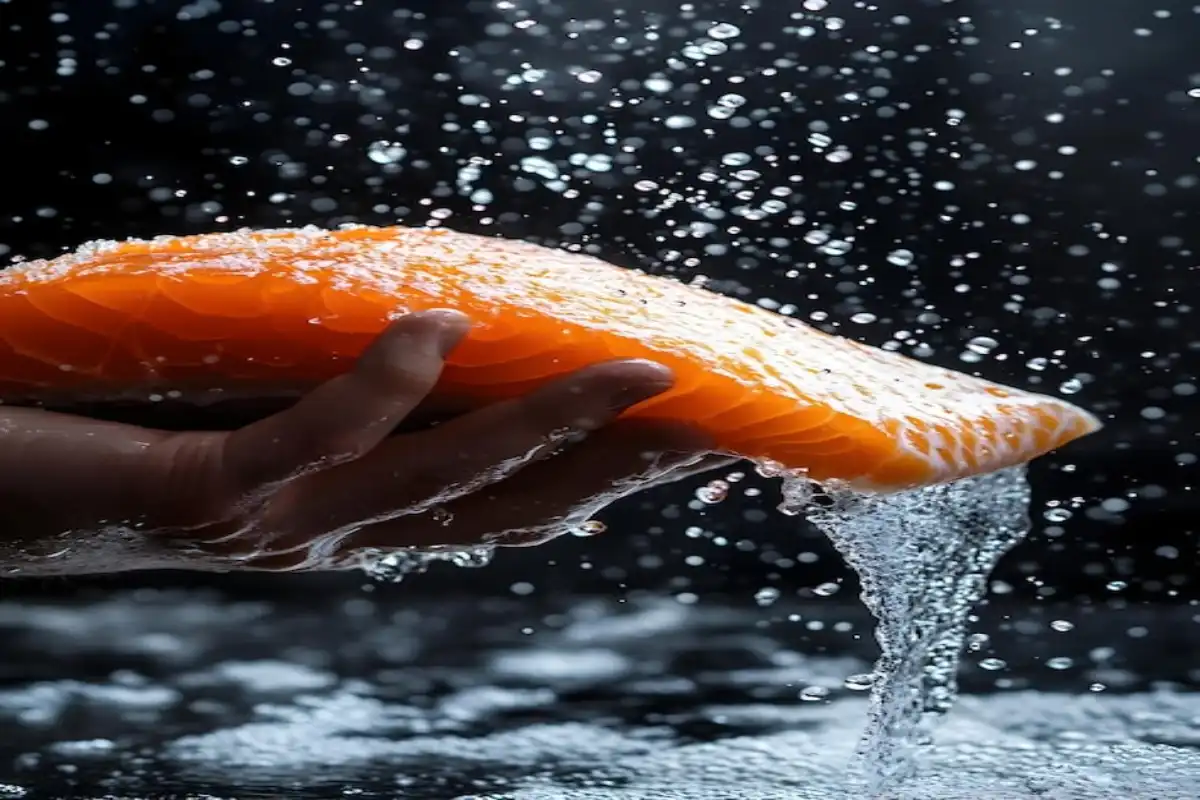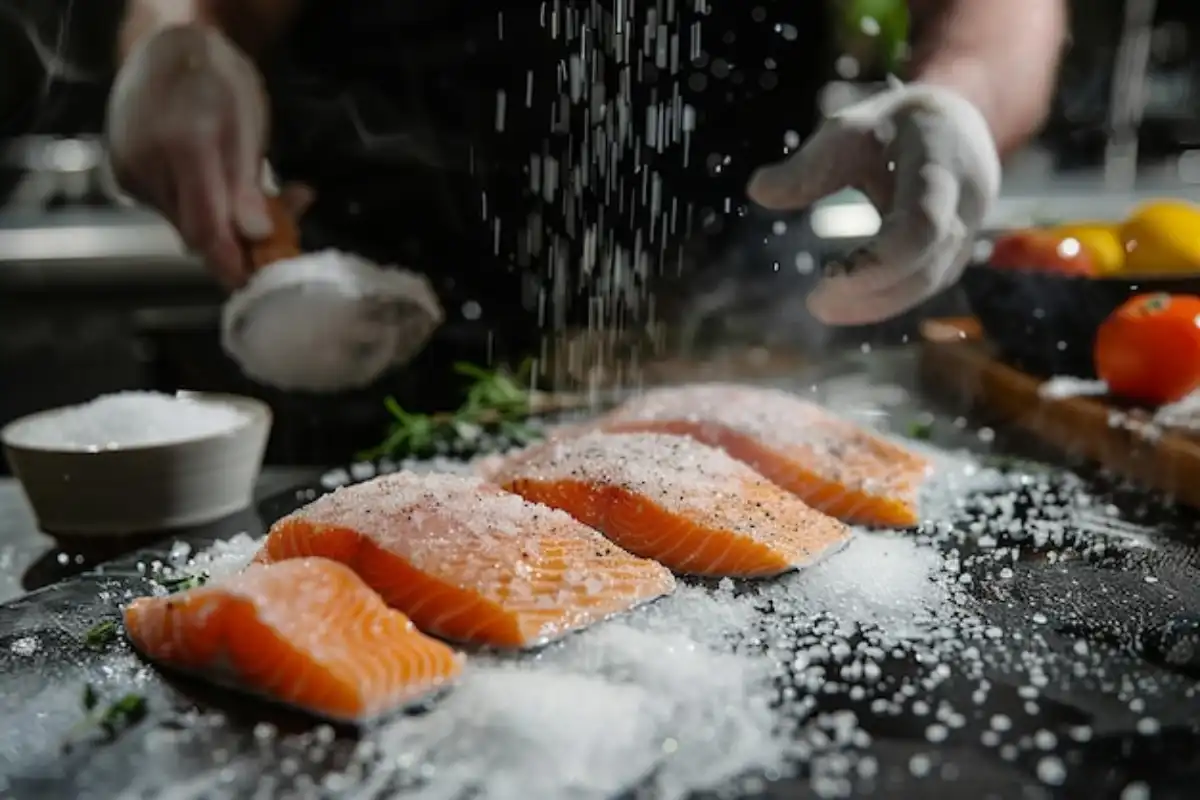Salmon is one of the most popular and nutritious fish globally, known for its rich flavor, versatility, and health benefits. When preparing salmon, many chefs and home cooks recommend soaking it in salt water. But why is this step so important? Soaking salmon in salt water, also known as brining, serves multiple purposes—from enhancing flavor to improving texture and removing any unwanted odors.
In this article, we’ll explore the reasons behind soaking salmon in salt water, the science behind the process, and how to properly brine salmon for the best results. Additionally, we’ll discuss the health benefits of brining and answer some common questions. By the end of this guide, you’ll understand why this simple step can make a huge difference in the quality of your salmon dishes.
Part 1: Introduction to Soaking Salmon in Salt Water
Soaking salmon in salt water is a process called brining, commonly used in seafood and meat preparation. It involves submerging the fish in a solution of water and salt for a specific period before cooking. There are two main types of brining: wet brining, where the salmon is soaked in a saltwater solution, and dry brining, where salt is rubbed directly onto the surface of the fish.
Why Soak Salmon in Salt Water?
Brining salmon before cooking enhances its flavor and texture while helping to preserve its natural moisture. Salmon is known for being a delicate fish, and the brining process allows the fish to retain its moisture during cooking, preventing it from drying out. Additionally, brining can help remove any lingering fishy odor, making the final dish more palatable.
When soaking salmon in salt water, you can also add herbs and spices to the brine, infusing the fish with additional layers of flavor. This method is especially popular for dishes like smoked or grilled salmon, but it works well with baked, pan-seared, or broiled salmon too.
Part 2: Benefits of Soaking Salmon in Salt Water
Brining salmon offers several key benefits, making it a must-try technique for anyone looking to elevate their salmon dishes.
1. Enhancing Flavor
One of the primary reasons people soak salmon in salt water is to enhance its flavor. Salt acts as a flavor enhancer, drawing out the fish’s natural taste while simultaneously reducing the fishy odor that can sometimes linger. The brining process also allows for the inclusion of other ingredients like garlic, herbs, and lemon zest to further elevate the flavor profile of the salmon.
2. Removing Unwanted Odors
Fish, particularly salmon, can sometimes carry a strong odor. Soaking salmon in salt water helps neutralize this odor, making the final dish more appealing. The salt in the water absorbs some of the compounds responsible for the fishy smell, leaving behind a cleaner and fresher taste.
3. Improving Texture
The texture of salmon can sometimes be a concern for home cooks, especially if the fish turns out too soft or dry. Brining helps firm up the fish by denaturing its proteins, which locks in moisture and helps the salmon hold its shape during cooking. The result is a tender, flaky fish with a firm texture that is far more enjoyable to eat.
4. Moisture Retention
Salmon can dry out quickly during cooking, especially when baked or grilled. Brining helps the fish retain moisture by drawing water into its flesh. This results in a juicier, more succulent piece of fish, even when cooked at high temperatures.
5. Preserving Freshness
Historically, salt has been used as a preservative for fish and other foods. While modern refrigeration reduces the need for this, brining still helps keep the salmon fresh for a longer period, making it a useful technique for meal prepping or preparing salmon in advance.
For those new to cooking salmon, understanding how to select the best fish is essential. Check out this guide on How to Choose the Best Salmon for tips on selecting the highest quality fish.

Part 3: The Science Behind Soaking Salmon in Salt Water
Soaking salmon in salt water isn’t just a culinary trick—it’s grounded in food science. Let’s take a closer look at the scientific principles that make brining so effective.
1. Osmosis and Brining
Brining relies on the process of osmosis, where water and salt molecules move between the fish’s flesh and the brine solution. As the salmon soaks in the salt water, salt molecules penetrate the fish, drawing moisture into the cells and creating a more flavorful and moist texture. This exchange helps the salmon retain its juices during cooking, preventing it from drying out.
2. Role of Salt in Denaturing Proteins
When salmon is brined, the salt begins to denature the proteins in the fish. This means that the proteins start to break down and unwind, which allows the fish to absorb more moisture. The result is a firmer texture with a melt-in-your-mouth quality after cooking. Salt’s ability to change the structure of the proteins also explains why brined salmon tends to cook more evenly.
3. Importance of Salinity Levels
The strength of the brine solution plays a significant role in the outcome of your dish. A standard brine typically consists of one tablespoon of salt per cup of water. However, different brining recipes call for different salinity levels depending on the thickness and type of salmon being used. A lighter brine results in a milder flavor, while a heavy brine can impart a stronger saltiness and firmer texture.
Part 4: How to Properly Soak Salmon in Salt Water
To get the best results from soaking salmon in salt water, it’s important to follow the right steps.
1. Preparing the Brine
The standard brine for salmon is a mixture of water and salt. As a rule of thumb, use one tablespoon of salt for every cup of water. You can also add other ingredients to the brine for extra flavor, such as:
- Sugar (for a slightly sweet flavor)
- Lemon slices or zest
- Fresh herbs like dill, thyme, or parsley
- Garlic cloves or onion slices
2. Duration of Soaking
Soaking time is crucial. Typically, salmon should be soaked for about 15-30 minutes, depending on the thickness of the fillet. Thin fillets require less time, while thicker cuts of salmon can handle a longer soak. However, avoid over-soaking the fish, as it can become too salty or mushy if left in the brine for too long.
3. Drying the Salmon Before Cooking
Once the salmon has been soaked in salt water, it’s important to pat it dry with paper towels before cooking. This ensures a crispier texture on the outside, especially when baking or grilling.
4. Cooking Methods After Soaking
Brined salmon can be cooked using various methods. Here are some popular techniques:
- Baking: Bake the salmon in the oven for 10-12 minutes at 400°F, until it’s cooked through but still moist.
- Grilling: Grill the salmon over medium heat for 4-5 minutes per side, ensuring it has a crispy exterior.
- Pan-Searing: Heat a little oil in a skillet and sear the salmon for 3-4 minutes on each side, creating a golden crust while keeping the inside tender.
Brined salmon pairs beautifully with a variety of sides. For a comforting option, pair your salmon with a comforting side like this Ultimate Guide to Slow Cooker Soup.
Part 5: Variations of Brining for Salmon
There are different types of brining methods, and you can adjust the flavor to suit your personal preferences.
1. Dry Brining vs. Wet Brining
While wet brining is the most common method, dry brining involves rubbing salt directly onto the surface of the salmon, allowing it to sit for several hours. Dry brining can result in a more concentrated flavor, but wet brining is generally preferred for its moisture retention.
2. Flavorful Additions to Brines
To enhance the flavor of your brine, you can add:
- Herbs: Dill, thyme, rosemary
- Citrus: Lemon or orange slices
- Spices: Peppercorns, fennel seeds, or cumin
- Sugar: For a touch of sweetness, add brown sugar or honey to the brine.
3. Quick Brining vs. Long Brining
Quick brining involves soaking the salmon for 10-15 minutes for a mild flavor boost, while long brining can take up to an hour. The longer the fish is brined, the stronger the flavor and texture.
Part 6: Nutritional Benefits of Soaking Salmon in Salt Water
Brining salmon doesn’t just improve the flavor and texture—it also has nutritional benefits.
1. Retaining Omega-3 Fatty Acids
Omega-3 fatty acids are one of the key nutrients found in salmon, and brining helps preserve these healthy fats during cooking. These fatty acids are essential for heart health and reducing inflammation. Learn more about the Benefits of Omega-3 Fatty Acids.
2. Sodium Content and Health Considerations
While brining does increase the sodium content of the salmon, it’s important to enjoy brined fish in moderation. The added salt is balanced out by the health benefits of the salmon’s protein and healthy fats.
3. Lowering the Risk of Overcooking
Brining acts as a protective barrier, helping the salmon retain moisture and preventing it from becoming dry and overcooked. This makes it easier to achieve perfectly cooked salmon every time.
Part 7: FAQs About Soaking Salmon in Salt Water
1. Why do you soak salmon in salt water before cooking?
Soaking salmon in salt water enhances its flavor, improves its texture, and helps retain moisture during cooking.
2. How long should I soak salmon in salt water?
Typically, salmon should be soaked for 15–30 minutes. Thin fillets require less time, while thicker cuts benefit from a longer soak.
3. Can you brine salmon with other ingredients besides salt?
Yes, you can add ingredients like sugar, herbs, garlic, and citrus to the brine for added flavor.
4. Does soaking salmon in salt water make it salty?
When done properly, brining should not make the salmon overly salty. The salt enhances the natural flavors without overpowering them.
5. What happens if you soak salmon for too long?
If salmon is over-soaked, it can become too salty or mushy. Stick to the recommended brining times to avoid this.
Part 8: What to Serve with Brined Salmon
Brined salmon pairs well with a variety of side dishes. Here are some ideas:
1. Complementary Side Dishes
- Roasted vegetables like asparagus or Brussels sprouts
- Mashed potatoes or wild rice
- A fresh salad with a light vinaigret
2. Wine Pairings
Brined salmon pairs beautifully with crisp white wines like Sauvignon Blanc or Chardonnay. For a non-alcoholic option, try sparkling water with a slice of lemon.
For more meal inspiration, try this Garlic Parmesan Chicken Pasta Recipe.
Conclusion
Soaking salmon in salt water is a simple yet effective way to enhance its flavor, texture, and moisture content. Whether you’re grilling, baking, or pan-searing salmon, brining can help you achieve a more tender and flavorful dish. By understanding the science behind brining and experimenting with different flavors, you can elevate your salmon dishes to new heights.
For more easy-to-make salmon recipes, check out this collection of Easy Healthy Salmon Recipes. And for a lighter dessert after your brined salmon meal, check out this easy No-Bake Cheesecake Filling.
Brining salmon is an essential technique for any seafood lover, and once you try it, you’ll never want to cook salmon without it again.
